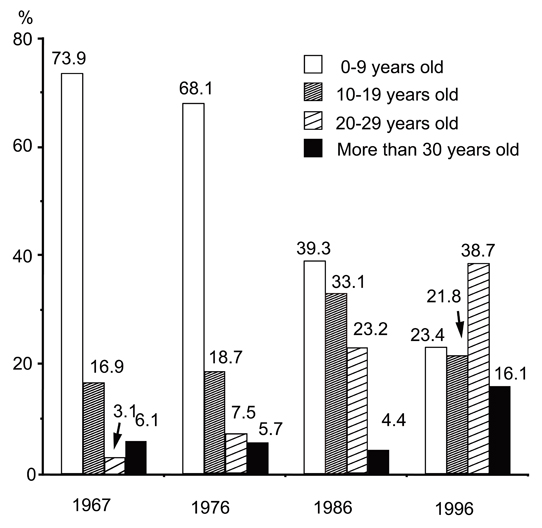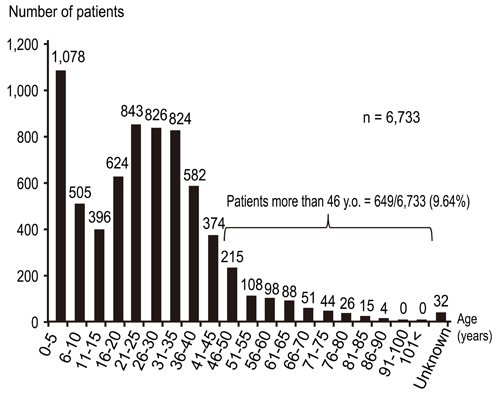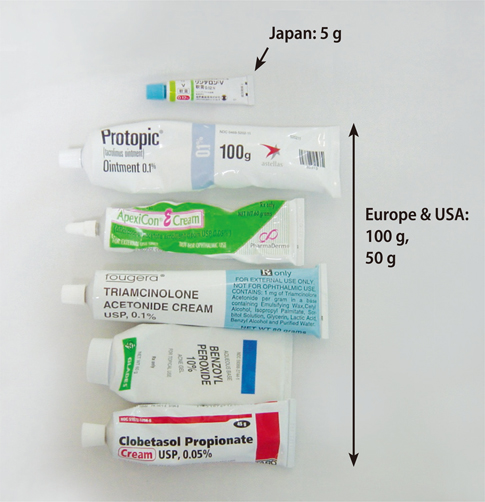Asia Pac Allergy.
2011 Jul;1(2):64-72. 10.5415/apallergy.2011.1.2.64.
Current status of atopic dermatitis in Japan
- Affiliations
-
- 1Department of Dermatology, Graduate School of Medical Sciences, Kyushu University, Fukuoka 812-8582, Japan. furue@dermatol.med.kyushu-u.ac.jp
- KMID: 2397164
- DOI: http://doi.org/10.5415/apallergy.2011.1.2.64
Abstract
- Atopic dermatitis (AD) is a common, chronic or chronically relapsing, severely pruritic, eczematous skin disease. AD is the second most frequently observed skin disease in dermatology clinics in Japan. Prevalence of childhood AD is 12-13% in mainland Japan; however, it is only half that (about 6%) in children from Ishigaki Island, Okinawa. Topical steroids and tacrolimus are the mainstay of treatment. However, the adverse effects and emotional fear of long-term use of topical steroids have induced a "topical steroid phobia" in patients throughout the world. Undertreatment can exacerbate facial/periocular lesions and lead to the development of atopic cataract and retinal detachment due to repeated scratching/rubbing/patting. Overcoming topical steroid phobia is a key issue for the successful treatment of AD through education, understanding and cooperation of patients and their guardians.
Keyword
MeSH Terms
Figure
Cited by 2 articles
-
Personalized Immunomodulatory Therapy for Atopic Dermatitis: An Allergist's View
Dong-Ho Nahm
Ann Dermatol. 2015;27(4):355-363. doi: 10.5021/ad.2015.27.4.355.Early intervention in the management of atopic dermatitis
Donald Y.M. Leung
Asia Pac Allergy. 2011;1(2):51-52. doi: 10.5415/apallergy.2011.1.2.51.
Reference
-
1. Williams HC. Is the prevalence of atopic dermatitis increasing? Clin Exp Dermatol. 1992. 17:385–391.
Article2. Williams HC, Robertson C, Stewart A. Worldwide variations in the prevalence of symptoms of atopic eczema in the International Study of Asthma and Allergies in Childhood. J Allergy Clin Immunol. 1999. 103:125–138.
Article3. Takeuchi M, Ueda H. Increase of adult atopic dermatitis (AD) in recent Japan. Environ Dermatol. 2000. 7:133–136.4. Sugiura H, Umemoto N, Deguchi H, Murata Y, Tanaka K, Sawai T, Omoto M, Uchiyama M, Kiriyama T, Uehara M. Prevalence of childhood and adolescent atopic dermatitis in a Japanese population: comparison with the disease frequency examined 20 years ago. Acta Derm Venereol. 1998. 78:293–294.5. Sulzberger MB. Historical notes on atopic dermatitis: Its names and nature. Semin Dermatol. 1983. 2:1–4.6. Hill LW, Sulzberger MB. Evolution of atopic dermatitis. Arch Dermatol Syph. 1935. 32:451–463.
Article7. Wise F. The neurodermatoses and pseudo-lichens: a consideration of their nosological and clinical features. J Cutan Dis. 1919. 37:590–620.8. Low RC. The eczema-asthma-prurigo-complex. Br J Dermatol. 1928. 40:389–406.9. Coca AF, Cooke RA. On the classification of the phenomena of hypersensitiveness. J Immunol. 1923. 8:163–182.10. Drake JA. The asthma-eczema-prurigo complex. Br J Dermatol. 1928. 40:407–414.
Article11. Sulzberger MB, Spain WC, Sammis F, Shahon HI. Studies in hypersensitiveness in certain dermatoses. I. Neurodermatitis (disseminated type). J Allergy. 1932. 3:423–437.12. Hill LW. Chronic atopic eczema (neurodermatitis) in childhood. JAMA. 1934. 103:1430–1434.
Article13. Sulzberger MB, Rostenberg A Jr. Practical procedures in the investigation of certain allergic dermatoses. J Allergy. 1935. 6:448–459.
Article14. Schultz Larsen F. Atopic dermatitis: a genetic-epidemiologic study in a population-based twin sample. J Am Acad Dermatol. 1993. 28:719–723.15. Edfors-Lubs ML. Allergy in 7000 twin pairs. Acta Allergol. 1971. 26:249–285.
Article16. Furue M. Tamaki K, Furue M, Nakagawa H, editors. History of atopic dermatitis. Atopic dermatitis and topical steroid therapy. 1998. Shinjuku: Chugai-Igakusha;1–19.17. Furue M, Yamazaki S, Jimbow K, Tsuchida T, Amagai M, Tanaka T, Matsunaga K, Muto M, Morita E, Akiyama M, Soma Y, Terui T, Manabe M. Prevalence of dermatological disorders in Japan: a nationwide, cross-sectional, seasonal, multicenter, hospital-based study. J Dermatol. 2011. 38:310–320.
Article18. Yura A, Shimizu T. Trends in the prevalence of atopic dermatitis in school children: longitudinal study in Osaka Prefecture, Japan, from 1985 to 1997. Br J Dermatol. 2001. 145:966–973.
Article19. Yura A, Kouda K, Iki M, Shimizu T. Trends of allergic symptoms in school children: large-scale long-term consecutive cross-sectional studies in Osaka Prefecture, Japan. Pediatr Allergy Immunol. 2011. doi: 10.1111/j.1399-3038.2011.01159.x. [Epub ahead of print].
Article20. Yamamoto S. Prevalence and exacerbation factors of atopic dermatitis. Skin Allergy Frontier. 2003. 1:85–90.21. Hamada M, Furusyo N, Urabe K, Morita K, Nakahara T, Kinukawa N, Nose Y, Hayashi J, Furue M. Prevalence of atopic dermatitis and serum IgE values in nursery school children in Ishigaki Island, Okinawa, Japan. J Dermatol. 2005. 32:248–255.
Article22. Fukiwake N, Furusyo N, Kubo N, Takeoka H, Toyoda K, Morita K, Shibata S, Nakahara T, Kido M, Hayashida S, Moroi Y, Urabe K, Hayashi J, Furue M. Incidence of atopic dermatitis in nursery school children - a follow-up study from 2001 to 2004, Kyushu University Ishigaki Atopic Dermatitis Study (KIDS). Eur J Dermatol. 2006. 16:416–419.23. Kawaguchi H, Takeuchi M, Tanaka Y, Ishii N, Ikezawa Z. Atopic dermatitis at 18-months physical examination. Arerugi. 2000. 49:653–657.24. Illi S, von Mutius E, Lau S, Nickel R, Grüber C, Niggemann B, Wahn U. Multicenter Allergy Study Group. The natural course of atopic dermatitis from birth to age 7 years and the association with asthma. J Allergy Clin Immunol. 2004. 113:925–931.25. Anan S, Yamamoto N. Spontaneous regression of atopic dermatitis. Hifu. 1996. 38:suppl 18. 13–15. (in Japanese).26. Okano S, Takahashi H, Yano T, Yamura M, Niimi N, Tanaka K, Iguchi H, Nakayama S, Horie M, Kuwahara M, Oda K, Hashimoto N, Doi T, Okino H, Imoo K, Doki M. Prevalence of childhood atopic dermatitis in first-year pupils of elementary school and its follow-up: Asa district in Hiroshima. Nihon Ishikai Zasshi. 2006. 135:97–103. (in Japanese).27. Williams HC, Strachan DP. The natural history of childhood eczema: observations from the British 1958 birth cohort study. Br J Dermatol. 1998. 139:834–839.
Article28. Uehara M, Otaka T, Ogawa Y, Ofuji k. Clinical course of atopic dermatitis. Hifuka-Kiyo. 1970. 65:1–6.29. Furue M, Kawashima M, Furukawa F, Iiduka H, Ito M, Shiohara T, Shimada S, Takigawa M, Takehara K, Miyaji Y, Katayama I, Iwatsuki K, Hashimoto K. Questionnaire study for chronological change in atopic dermatitis. Rinshohifuka. 2007. 61:286–295.30. Furue M, Kawashima M, Furukawa F, Iiduka H, Ito M, Shiohara T, Shimada S, Takigawa M, Takehara K, Miyaji Y, Katayama I, Iwatsuki K, Hashimoto K. A prospective questionnaire study for atopic dermatitis. Rinshohifuka. 2011. 65:83–92.31. Furue M, Hayashida S, Uchi H. Natural history of atopic dermatitis. Rinshomeneki-Arerugika. 2009. 52:320–325.32. Charman CR, Morris AD, Williams HC. Topical corticosteroid phobia in patients with atopic eczema. Br J Dermatol. 2000. 142:931–936.
Article33. Furue M, Terao H, Rikihisa W, Urabe K, Kinukawa N, Nose Y, Koga T. Clinical dose and adverse effects of topical steroids in daily management of atopic dermatitis. Br J Dermatol. 2003. 148:128–133.
Article34. Brunsting LA. Atopic dermatitis (disseminated neurodermatitis) of young adults. Arch Derm Syphilol. 1936. 34:935–957.
Article35. Wilson L, Williams DI, Marsh SD. Plasma corticosteroid levels in outpatients treated with topical steroids. Br J Dermatol. 1973. 88:373–380.
Article36. Munro DD, Clift DC. Pituitary-adrenal function after prolonged use of topical corticosteroids. Br J Dermatol. 1973. 88:381–385.
Article37. Furue M, Terao H, Moroi Y, Koga T, Kubota Y, Nakayama J, Furukawa F, Tanaka Y, Katayama I, Kinukawa N, Nose Y, Urabe K. Dosage and adverse effects of topical tacrolimus and steroids in daily management of atopic dermatitis. J Dermatol. 2004. 31:277–283.
Article38. Long CC, Finlay AY. The finger-tip unit--a new practical measure. Clin Exp Dermatol. 1991. 16:444–447.
Article39. Brunsting LA, Reed WB, Bair HL. Occurrence of cataracts and keratoconus with atopic dermatitis. AMA Arch Derm. 1955. 72:237–241.
Article40. Goldman L, Thompson RG, Trice ER. Cortisone acetate in skin disease; local effect in the skin from topical application and local injection. AMA Arch Derm Syphilol. 1952. 65:177–186.41. Haeck IM, Rouwen TJ, Timmer-de Mik L, de Bruin-Weller MS, Bruijnzeel-Koomen CA. Topical corticosteroids in atopic dermatitis and the risk of glaucoma and cataracts. J Am Acad Dermatol. 2011. 64:275–281.
Article42. Taniguchi H, Ohki O, Yokozeki H, Katayama I, Tanaka A, Kiyosawa M, Nishioka K. Cataract and retinal detachment in patients with severe atopic dermatitis who were withdrawn from the use of topical corticosteroid. J Dermatol. 1999. 26:658–665.
Article43. Nagaki Y, Hayasaka S, Kadoi C. Cataract progression in patients with atopic dermatitis. J Cataract Refract Surg. 1999. 25:96–99.
Article44. Matsuo T, Saito H, Matsuo N. Cataract and aqueous flare levels in patients with atopic dermatitis. Am J Ophthalmol. 1997. 124:36–39.
Article45. Saeki H, Furue M, Furukawa F, Hide M, Ohtsuki M, Katayama I, Sasaki R, Suto H, Takehara K. Committee for Guidelines for the Management of Atopic Dermatitis of Japanese Dermatological Association. Guidelines for management of atopic dermatitis. J Dermatol. 2009. 36:563–577.
Article46. Yoshida H, Aoki T, Furue M, Tagami H, Kaneko F, Ohtsuka F, Nishioka K, Toda K, Mizoguchi M, Nakayama H, Ikezawa Z, Takigawa M, Arata J, Yamamoto S, Tanaka Y, Ishigaki M, Kusunoki T, Yoshikawa K. English version of the interim report published in 1998 by the members of the Advisory Committee on Atopic Dermatitis Severity Classification Criteria of the Japanese Dermatological Association. J Dermatol. 2011. 38:625–631.
Article47. Aoki T, Yoshida H, Furue M, Tagami H, Kaneko F, Ohtsuka F, Nishioka K, Toda K, Mizoguchi M, Ichihashi M, Ueki H, Nakayama H, Ikezawa Z, Takigawa M, Arata J, Koro O, Yamamoto S, Tanaka Y, Ishigaki M, Kusunoki T, Yoshikawa K. English version of the concluding report published in 2001 by the Advisory Committee on Atopic Dermatitis Severity Classification Criteria of the Japanese Dermatological Association. J Dermatol. 2011. 38:632–644.
- Full Text Links
- Actions
-
Cited
- CITED
-
- Close
- Share
- Similar articles
-
- Measurement of Atopic Dermatitis Disability
- A Study on the Cell - Mediated Immunity of Patients with Apopic Dermatitis
- Serum IgE Level in Patients of Atopic Dermatitis and Atopic Dermatitis with Molluscum Contagiosum
- Nipple Involvement in Atopic Dermatitis: Report of 3 cases
- Current Understanding of Atopic Dermatitis




